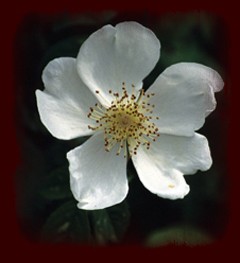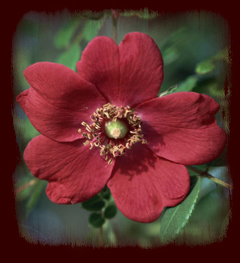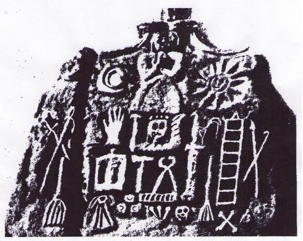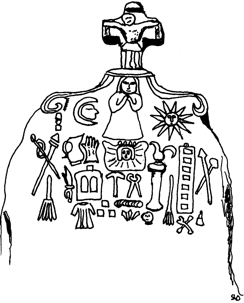
CLAN OF TUBAL CAIN

St. Uzec and the Mysteries of Tubal Cain -by Shani Oates |
||||||||||||||||||||||||||||||||||||||||||||||||||||||
In ‘Roebuck in the Thicket’ (1) E. J. Jones develops his explanation of the Male and Female Mysteries of the Clan of Tubal Cain. Specifically, he mentions the division of The Clan [of Tubal Cain] into holders of the Male and Female Mysteries headed by The Maid and The Magister respectively. A third section of the ‘Faith’ that encapsulated the ‘Priestly Mysteries’ was claimed by Robert Cochrane to have been lost ‘a long time ago.’ John taught me this was his bemoaning of an acute lack of spirituality within Craft practices extant during the 60’s, such that their recovery would present an arduous and grueling Quest. In order to avoid confusion between these Triune Mysteries and [the three] working sites relevant to the Priestly Mysteries alone, John clarifies this querulous issue further by discussing Cochrane’s belief that some of the old Traditional Clans [including his own] had once been large enough to allocate a site specific to [each of three] particular [priestly] rites to smaller gatherings [known as guardians] within each Clan who were responsible for its maintenance and security. Knowledge of those distinct sites was even acknowledged externally between these and other Families or Clans prior to their dissociation [expressed here as 'for fear of persecution', though more] probably due to a decline in opportunity and interest in the post war aftermath of the 1950's [Cochrane confirms this elsewhere]. (4) Of course, due to over four decades of a working model established through a high ‘Wiccan’ media saturation, it is almost impossible for any alternative to now be envisaged, less still accepted by a general consensus labouring under a perspective contra to Traditional Craft praxes. Nevertheless, many such alternatives do remain within the varied yet related practices of Traditional Craft. Cochrane clearly stated this (2) within his disclosure that for some Traditional ‘Families’ the Male and Female Mysteries were practised separately, except for when they came together for the Nine Knots of the year.(3) In short, this meant that considerable tutoring in both the ‘arts’ and intrinsic Cosmology occurred in-between those seasonal rites, being the duty of the Maid and Magister to instruct those under their charge, wherever dispersed. Only once this basic teaching is properly understood, may seasoned workers then engage the Priestly Mysteries, these being those of the ‘Cave’, the ‘Grave’ and the ‘Castle.’ (5) Apparently, even though the Male and Female Mysteries had become combined decades before Cochrane retrieved his legacy, it was his belief that this somehow denuded their distinctive virtue and it was his hope that the Male and Female Mysteries would once again be taught separately. (6) After the death of E. J. Jones in August 2003, his widow kindly gave permission to reprint Robert Cochrane’s original article entitled ‘A Hereditary Witch’s Revelations’ in The Cauldron #112. This had been intentionally written by Cochrane for a chapter in a book penned by Justin Glass entitled: ‘Witchcraft and the Sixth Sense.’ In it, Robert Cochrane discusses a 4,000 year old Menhir in Brittany upon which were carved numerous symbols by Jesuit Priests sometime during the 17th Century depicting Christ’s ‘Passion.’ Despite this clear Christian context, Cochrane maintained that these symbols reveal significant factors relative to the Male and Female Mysteries of the ‘Old Craft.’(7) His idiosyncratic interpretations however, are concerned with variant working crafts, reflecting a nostalgic period within the Craft’s history; nonetheless, these comments remain a noteworthy study of Craft Traditions [see Menhir of St Uzec 1©ref: Justine Glass]. Carved into three rough ‘columns,’ the symbols fall easily into their suggested formats. Cochrane suggested that a central figure of a Crowned [Priest] King supports the image of a bell skirted Female deity. Recent photographs reveal this observation as unlikely. The Menhir and its carvings require closer inspection and substantial revision. Its symbology, grounded in the ‘Faith’ still merits considerable magnitude to many [though not all] Old Craft Traditions. Moreover it is really unimportant whether or not Robert Cochrane was misrepresenting or misinterpreting these symbols, as his intention was to express a given formulae, whose graphics reveal a narrative of an especial relevance to those keen of eye and wit. Cochrane was also determined to confirm a working philosophy both compatible and in some ways comparable to the Qabbalah, yet presented on its own terms relative to Traditional Craft praxes. He refers again to these enigmatic formulae when discussing the Male and Female Mysteries to Joe Wilson, (8) and to the ‘order’ of 1734. In this respect, the MONOlith [the One], describes the tools of the Passion as sets of ‘Seven’ over ‘Three’ columns, that collectively underpin the tetradic philosophy of the Sun, Moon, Venus and Christos: 1734 [see Menhir of St Uzec 2 ©Shani Oates] Though abstruse, the symbols may be read with equal relevance to both the Craft and Christianity, a common occurrence to many of that period regarding dual faith practices. Cogently, the female figure placed centrally upon the Menhir, resting between the Sun and Moon, suggests a third Stellar association common to Trinities of the more ancient world, and which is also reflected within the Christian trinity where Mary stands upon the Lunar Barque with a halo of stars above her head. In this she may be compared to the Magdalene and to Mary, the Mother....and to even earlier female numinous deities such as Ishtar and Asherah. Below her floats a head, reminiscent of the Veil of Veronica, the simulacra of the ‘Christos,’ which may also be seen as the shroud or wrappings of the mendicant; he who rests so close to spirit he straggles both worlds of the living and the dead. Next we see the hammer and tongs of working craft especially that of Smith Craft; gnosis of these arts were the remit of the early Priest Kings, whose superior privileges and ancient gnosis determine the imposition of Will over the elements to forge and temper the tools of civilization – the gift of the Gods. His symbols total a significant 7. On the left, under the Moon (waning crescent and profile of a face, possibly of Cain) are listed the 7 tools relative to the female Mysteries and to the right, under the blazing Sun are 7 relative to the Male Mysteries. Upon this enigmatic Menhir then are three sets of seven tools [21], a depiction of Triune deity in the form of the Sun, the Moon and Venus [3] and one more, the One that supersedes them all, that of the sacrificial Christos. This gives us the 24 +1….the number of the spirit/wind forces relative to the full Compass of Clan Tubal Cain as derived from the five points of the pentagram. The Menhir itself becomes the One beyond the ‘25’(9) as the sacred Omphalos, the Ben Ben stone of Creation, the conjoining of Heaven and Earth, the Unhewn Dolmen of the Void. This Monolith stands as a marker of the ‘Stones’ that ‘fell’ from Heaven, inscribed with gnosis for all who care to read it. There are clear parallels to the Qabbalistic Tree of Life, whom the Christos (ergo, by default, also Lucifer) was likened to, following a long established belief in avatars. Cogently, in common with many esoteric practices, the left and right side of the human body is said to correspond with that of the divine 'form' - the two sides that generate the Tao, the holism of the 'One'...this is expressed both philosophically and metaphorically through the 'Tree of Life' (a map of the divine Universe. or body of 'god') pertinent most within the traditions of the Qabbala and all those influenced by it. It is form and force, light and dark, active and passive - mercy and severity (also perceived as justice) expansion and contraction...order and chaos.. through unity of these potencies, we acquire Grace, located centrally within the middle pillar. Divine prayer and interaction with deity suffuses and purifies the soul of 'man' The dark pillar [left] represents Will, Discipline, Law, Strength, the Moon (all things Hidden) and is the Grail Castle and the Dark cherub upon the Arc of the Covenant. She is thus the ambivalent force of karma, of Fate and of the destructive cleansing of all that is rotten to make room for all that is created (Kali is the best example of this).. Though the two pillars are often misrepresented as polarised qualities, they are not, as each partakes of its counterpart across the central 'divide' as the lightening flash descends from Kether [the Crown/top] to Malkuth [The Kingdom/base] Originally these two pillars were sourced from within the Egyptian 'Coming Forth by Day' text, being the North and South Pillars through which the Soul passed in Judgment in death. The Dark Pillar [Mother] was the Pillar of 'Shu' [female elements of moisture, wind-tempest. dust], - the Light Pillar [Father] was that of the 'Dawning Light' [and is of Fire], the Male element. With regard to the 'Covenant' the Maid therefore represents the highest Will, while her Magister represents the highest Love. Hence the Thelemic maxim - 'Love under Will', the realisation of which brings the aspirant 'Grace'. The Qabbala is not the easiest of theologies to grasp when first introduced to it. When studied with intent it does reveal its secrets to you. Perhaps a useful exercise might be to list all of the male and female qualities in two separate columns, left and right, not forgetting to place Force on the left feminine side and Form on the right masculine side. This graphic provides a visual narrative; then, after careful study of it rotate the image 90 degrees clockwise, so that the dark Force left Pillar is above and the Light Form right Pillar is below. Finally, in your minds eye superimpose the image of Kali dancing on the inert body of Shiva. In this graphic Kali, the dark and terrible Mother dances in wild ecstasy upon the corpse of her spouse the Lord Shiva who has become the sacrifice of matter the Form to Her Force [Shakti]. She is the Cosmic Dance of all Creation. She represents the Void and all things that come from it and are returned to it. Through Him She generates all Life and Death - He mediates Her Force. Together they represent Love [His] Under Will [Hers], a primal and eternal unity. Within our Craft we perceive the Mother as the All with the Male as the Gateway to Her. He is All Matter therefore the Lord of this World. Shiva, therefore, represents the more mystical elements of a male deity of priestly disipline. These qualities must not be seen in the negative or postive, they are just complimentary ambivalent potencies. Within the Craft, these have been adopted to explain the modalities of use. The Maid embodies the potencies of the Left side of the Tree of Life through the highest Will and intellect through Saturn the Father residing in the Abzu Sea of Mara-Binah [which crosses over through Daath]. She serves Balance by teaching the Craft's Masculine Mysteries of Law and Disipline listed oppositely, upon the Solar right hand Pillar of Mercy. Conversely, the Lunar Left Hand Pillar of Severity on the menhir has drawn the Mother/Chocmah [also crossing over through Daath] to act through the Right Hand qualities imbued by the Magister, who equally asserts Balance by teaching the more intuitive Craft Feminine Mysteries of Love, Compassion, and all Civilising Arts expanded through Her Wisdoms. Therefore the Menhir lists all the tools of 'Severity' under the Moon and all the tools of Mercy under the Sun. Collectively, these concepts may be explained as follows in terms of the Compass, asserting a ‘Standard’ and symbols for each Cardinal point:
The Male Mysteries are Death (The Father):
The Female Mysteries are Life (The Mother):
The Priestly Mysteries are Gnosis (The Son):
Symbols are of course a device by which a quality is condensed and represented graphically. Naturally within the Clan of Tubal Cain we have our own understanding of what such symbols mean to us and how we would use them according to Clan Cosmology and its particular Mythos. Each one ‘holds’ an idea, waiting to inspire us. They contain something of the virtue of that which they represent. Context is everything. As such they can generate a myriad comprehensions, so the intention of the artist hardly matters, as it is the viewer who ‘reads’ them. Layers of meaning need not conflict either. And these innovative correspondences do not in any way diminish those suggested by Robert Cochrane, who like many true Masters be they Rabbis , Shaykhs, Priests, or Brahmins, were and are able to use whatever subject matter is to hand to express through analogous use of parable, a profound revelation. By way of an example, this brings to mind the time a Sufi Shaykh held up one of my glass coasters during a visit and was able to explain the meaning and purpose of the Soul by it. Many interpretations of these images are possible and all of them will express elements of profound truth. These are offered here to exemplify how we may all ‘read’ that Truth to discover for ourselves the purpose of its Beauty within a Universe we all inhabit. Blake understood this when he articulated within his verse that ‘To see a world in a grain of sand, and a heaven in a wild flower, hold infinity in the palm of your hand and eternity in an hour’…is to perceive that everywhere the divine is not only reflected, but mediates a gnosis relevant to who we are, wherever we are upon our own path …we have only to look. All is One and One is All. Menhir of St. Uzec (1)
According to Robert Cochrane (10) the symbols here are to be read as follows: Right Column, under the Sun= ladder, cockerel upon a pillar, javelin and blackthorn stave, scourge, Left Column, under the Moon = glove, vase, flask, tabard, spinner’s distaff, sword and broom, beneath these the line of ‘Priestly’ mysteries are represented by = three squares, three nails, skull, crossed bones and a sacred bell. In the centre the God is featured with his hammer and tongs; the figure above him is that of the Goddess.(11) Menhir of St. Uzec (2)
Notes and refs:
http://muninnskiss.livejournal.com/24124.html http://muninnskiss.livejournal.com/68053.html http://commons.wikimedia.org/wiki/Category:Menhirs_of_Bretagne provides other links to some clear and recent photos of this menhir This brief study is by no means exhaustive, and is on-going… This article first appeared in this form in The Cauldron, May 2009, reproduced here with kind thanks to the editor, Mike Howard. |

